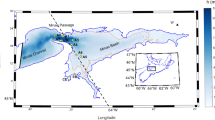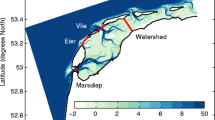Abstract
We investigate the dynamics of suspended sediment transport in a hypertidal estuarine channel which displays a vertically sheared exchange flow. We apply a three-dimensional process-based model coupling hydrodynamics, turbulence and sediment transport to the Dee Estuary, in the north-west region of the UK. The numerical model is used to reproduce observations of suspended sediment and to assess physical processes responsible for the observed suspended sediment concentration patterns. The study period focuses on a calm period during which wave-current interactions can reasonably be neglected. Good agreement between model and observations has been obtained. A series of numerical experiments aim to isolate specific processes and confirm that the suspended sediment dynamics result primarily from advection of a longitudinal gradient in concentration during our study period, combined with resuspension and vertical exchange processes. Horizontal advection of sediment presents a strong semi-diurnal variability, while vertical exchange processes (including time-varying settling as a proxy for flocculation) exhibit a quarter-diurnal variability. Sediment input from the river is found to have very little importance, and spatial gradients in suspended concentration are generated by spatial heterogeneity in bed sediment characteristics and spatial variations in turbulence and bed shear stress.












Similar content being viewed by others
References
Amoudry LO, Souza AJ (2011) Impact of sediment-induced stratification and turbulence closures on sediment transport and morphological modelling. Cont Shelf Res 31(9):912–928. doi:10.1016/j.csr.2011.02.014
Ariathurai CR (1974) A finite element model for sediment transport in estuaries. PhD thesis, University of California, Berkeley
Bass SJ, Aldridge JN, McCave IN, Vincent CE (2002) Phase relationships between fine sediment suspensions and tidal currents in coastal seas. J Geophys Res 107(C10). doi:10.1029/2001JC001269
Bolaños R, Souza A (2010) Measuring hydrodynamics and sediment transport processes in the Dee Estuary. Earth Syst Sci Data 2:157–165
Bolaños R, Amoudry LO, Doyle K (2011) Effects of instrumented bottom-tripods on process measurements. J Atmos Ocean Technol 28:827–837
Bolaños R, Brown JM, Amoudry LO, Souza AJ (2013) Tidal, riverine and wind influences on the circulation of a macrotidal estuary. J Phys Oceanogr 1:29–50. doi:10.1175/JPO-D-11-0156.1
Brown JM, Bolanos R, Wolf J (2011) Impact assessment of advanced coupling features in a tide-surge-wave model, POLCOMS-WAM, in a shallow water application. J Mar Syst 87:13–24
Brown JM, Amoudry LO, Mercier FM, Souza AJ (2013) Intercomparison of the charnock and coare bulk wind stress formulations for coastal ocean modelling. Ocean Sci 9:721–729
Brown JM, Bolanos R, Souza AJ (2014) Controls on monthly estuarine residuals: Eulerian circulation and elevation. Ocean Dyn. doi:10.1007/s10236-14-0698-5
Burchard H, Hetland RD (2010) Quantifying the contributions of tidal straining and gravitational circulation to residual corculation in periodically stratified tidal estuaries. J Phys Oceanogr 40:1243–1262
Burchard H, Bolding K, Villarreal MR (2004) Three-dimensional modelling of estuarine turbidity maxima in a tidal estuary. Ocean Dyn 54(2):250–265
Burchard H, Flöser G, Staneva JV, Badewien TH, Riethüller R (2008) Impact of density gradients on net sediment transport into the Wadden Sea. J Phys Oceanogr 38:566–587
Canuto VM, Howard A, Cheng Y, Dubovikov MS (2001) Ocean turbulence. Part I: one-point closure model—momentum and heat vertical diffusivities. J Phys Oceanogr 31:1413–1426
de Nijs MAJ, Pietrzak JD (2012) Saltwater intrusion and ETM dynamics in a tidally-energetic stratified estuary. Ocean Model 49–50:60–85
Geyer WR (1993) The importance of suppression of turbulence by stratification on the estuarine turbidity maximum. Estuaries 16(1):113–125
Holland KT, Elmore PA (2008) A review of heterogeneous sediments in coastal environments. Earth Sci Rev 89:116–134
Holt J, Umlauf L (2008) Modelling the tidal mixing fronts and seasonal stratification of the Northwest European continental shelf. Cont Shelf Res 28:887–903
Holt JT, James ID (2001) An s coordinate density evolving model of the northwest European continental shelf 1, model description and density structure. J Geophys Res 106(C7):14,015–14,034
Jago CF, Jones SE (1998) Observation and modelling of the dynamics of benthic fluff resuspended from a sandy bed in the southern North Sea. Cont Shelf Res 18:1255–1282
Jago CF, Jones SE, Sykes P, Rippeth T (2006) Temporal variation of suspended particulate matter and turbulence in a high energy, tide-stirred, coastal sea: relative contributions of resuspension and disaggregation. Cont Shelf Res 26:2019–2028
Jay DA, Musiak JD (1994) Particle trapping in estuarine tidal flows. J Geophys Res 99(C10):20,445–20,461
Jones SE, Jago CF, Simpson JH (1996) Modelling suspended sediment dynamics in tidally stirred and periodically stratified waters: progress and pitfalls. Mixing in estuaries and coastal seas, coastal and estuarine studies, vol 50. AGU, Washington DC, pp 302–324
Lynch JF, Irish J, Sherwood CR, Agrawal YC (1994) Determining suspended sediment particle size information from acoustical and optical backscatter measurements. Cont Shelf Res 14(10/11):1139–1165
MacDonald IT, Vincent CE, Thorne PD, Moate BD (2013) Acoustic scattering from a suspension of flocculatted sediments. J Geophys Res 118:2581–2594. doi:10.1002/jgrc.20197
Moore RD, Wolf J, Souza AJ, Flint SS (2009) Morphological evolution of the Dee Estuary eastern Irish Sea, UK: a tidal asymmetry approach. Geomorphology 103:588–596
Nitsche FO, Ryan WBF, Carbotte SM, Bell RE, Slagle A, Bertinado C, Flood R, Kenna T, McHugh C (2007) Regional patterns and local variations of sediment distribution on the Hudson River estuary. Estuar Coast Shelf Sci 71(1-2):259–277
Park K, Wang HV, Kim SC, Oh JH (2008) A model study of the estuarine turbidity maximum along the main channel of the upper Chesapeake Bay. Estuar Coasts 31:115–133
Prandle D (1997) Tidal characteristics of suspended sediment concentrations. J Hydraul Eng 123(4):341–350
Ralston DK, Geyer WR, Warner JC (2012) Bathymetric controls on sediment transport in the Hudson River estuary: lateral asymmetry and frontal trapping. J Geophys Res 117(C10013). doi:10.1029/2012JC008124
Ramirez-Mendoza R, Souza AJ, Amoudry LO (2014) Modelling flocculation in a hypertidal estuary. Ocean Dyn. 64(2):301–313. doi:10.1007/s10236-013-0675-4
Simpson JH, Souza AJ (1995) Semidiurnal switching of stratification in the region of fresh-water influence of the Rhine. J Geophys Res 100(C4):7037–7044
Simpson JH, Brown J, Matthews J, Allen G (1990) Tidal straining, density currents, and stirring in the control of estuarine stratification. Estuaries 13(2):125–132
Souza AJ, Lane A (2013) Effects of freshwater inflow on sediment transport. J Oper Oceanogr 6(1):27–31
Souza AJ, Alvarez LG, Dickey TD (2004) Tidally induced turbulence and suspended sediment. Geophys Res Lett 31(L20309). doi:10.1029/2004GL021186
Souza AJ, Holt JT, Proctor R (2007) Modelling SPM on the NW European shelf seas Coastal and shelf sediment transport. Geological Society of London, London, pp 147–158
Stanev EV, Brink-Spalink G, Wolff JO (2007) Sediment dynamics in tidally dominated environments controlled by transport and turbulence: a case study for the East Frisian Wadden Sea. J Geophys Res 112(C04018). doi:10.1029/2005JC003045
Thurston W (2009) Turbulence as a mediator of processes in a macrotidal estuary. PhD thesis, University of Leeds
Umlauf L, Bolding K, Burchard H (2005) GOTM—scientific documentsion. Version 3.2. Marine science reports 63. Leibniz-Institute for Baltic Sea Research, Warnemünde
van Straaten LMJU, Kuenen PH (1958) Tidal action as a cause of clay accumulation. J Sed Petrol 28(4):406–413
van der Wegen M, Dastgheib A, Jaffe BE, Roelvink D (2011) Bed composition generation for morphodynamic modeling: case study of San Pablo Bay in California, USA. Ocean Dyn 61(2-3):173–186
Weeks AR, Simpson JH, Bowers D (1993) The relationship between concentrations of suspended particulate material and tidal processses in the Irish Sea. Cont Shelf Res 13(12):1325–1334
Willmott CJ, Ackleson SG, Davis RE, Feddema JJ, Klink KM, Legates DR, O’Donnell J, Rowe CM (1985) Statistics for the evaluation and comparison of models. J Geophys Res 90(C5):8995–9005
Winterwerp JC (2011) Fine sediment transport by tidal asymmetry in the high-concentrated Ems River: indications for a regime shift in response to channel deepening. Ocean Dyn 61:203–215. doi:10.1007/s10236-010-0332-0
Acknowledgments
The authors acknowledge the funding from the Natural Environment Research Council via the iCOASST project (NERC grant NE/J005444/1) and via National Capability to the National Oceanography Centre. Rafeal Ramirez-Mendoza has been funded through a CONACYT scholarship (ID 212026).
The authors would like to thank J. Williams for providing meteorological data, C. O’Neill for providing boundary conditions for temperature and salinity as well as supplementing the meteorological forcing, and R. Bolaños for interesting discussions on hydrodynamics and sediment dynamics in the Dee Estuary. Finally, we wish to thank the two anonymous reviewers who helped to greatly improve the manuscript.
Author information
Authors and Affiliations
Corresponding author
Additional information
Responsible Editor: Rockwell Geyer
This article is part of the Topical Collection on Physics of Estuaries and Coastal Seas 2012
Rights and permissions
About this article
Cite this article
Amoudry, L.O., Ramirez-Mendoza, R., Souza, A.J. et al. Modelling-based assessment of suspended sediment dynamics in a hypertidal estuarine channel. Ocean Dynamics 64, 707–722 (2014). https://doi.org/10.1007/s10236-014-0695-8
Received:
Accepted:
Published:
Issue Date:
DOI: https://doi.org/10.1007/s10236-014-0695-8




